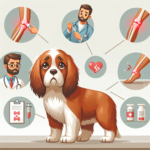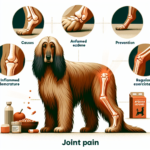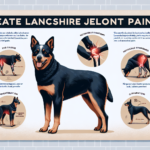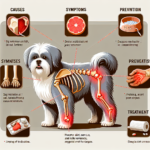Petit Basset Griffon Vendéen Joint Pain: Causes, Symptoms, Prevention, and Treatment

Introduction
The Petit Basset Griffon Vendéen, often affectionately referred to as the PBGV, is a small, energetic breed known for its distinctive appearance and lively personality. Originating from the Vendée region of France, this breed was initially developed for hunting small game, particularly rabbits. The PBGV is characterized by its rough, wiry coat, expressive eyes, and a cheerful demeanor that makes it a beloved companion for many dog enthusiasts.
While the PBGV is generally a healthy breed, it is not immune to certain health issues. Among these, joint pain is a significant concern that can affect the quality of life for these active dogs. Joint health is crucial for the PBGV, given their high energy levels and love for physical activity. Ensuring that their joints remain healthy is essential for maintaining their mobility and overall well-being.
Breed-Specific Joint Pain Risks
Genetic Predisposition
The Petit Basset Griffon Vendéen, like many other breeds, has a genetic predisposition to certain joint-related issues. Hip dysplasia, a condition where the hip joint does not fit properly into the hip socket, is one such concern. This can lead to arthritis and significant discomfort over time. Elbow dysplasia, another hereditary condition, affects the elbow joint and can cause similar issues. These genetic predispositions make it essential for breeders to screen for these conditions to reduce their prevalence in the breed.
Age-Related Risks
As the PBGV ages, the risk of developing joint pain increases. This is a common issue in many breeds, but it can be particularly pronounced in the PBGV due to their active nature. Owners should be vigilant as their dogs approach middle age, typically around 5-7 years old, and watch for signs of joint discomfort. Early detection and intervention can help manage these issues more effectively.
Activity Level and Joint Stress
The PBGV is a high-energy breed that thrives on physical activity. Whether they are participating in hunting activities, agility courses, or simply enjoying a vigorous play session, their joints are subjected to considerable stress. While regular exercise is beneficial for their overall health, excessive or inappropriate activity can exacerbate joint issues. It is crucial to strike a balance between keeping them active and not overburdening their joints.
Common Symptoms of Joint Pain in Petit Basset Griffon Vendéen
General Symptoms
Owners should be aware of several common symptoms that may indicate joint pain in their PBGV:
- Limping: A noticeable limp or favoring one leg over another can be a sign of joint pain.
- Stiffness: Difficulty in getting up or moving, especially after rest, can indicate joint discomfort.
- Reluctance to Move: A dog that is hesitant to jump, climb stairs, or engage in usual activities may be experiencing joint pain.
- Swelling: Visible swelling around the joints can be a sign of inflammation.
- Behavioral Changes: Increased irritability or changes in behavior can sometimes be linked to chronic pain.
Breed-Specific Symptoms
In the PBGV, symptoms of joint pain may manifest in specific ways due to their unique build and activity levels. For instance, they may show a marked decrease in their usual playful behavior or become less enthusiastic about activities they once enjoyed. Additionally, their distinctive gait may become more pronounced or awkward.
When to Consult a Vet
If any of the above symptoms are observed, it is crucial to consult a veterinarian promptly. Early diagnosis and treatment can significantly improve the prognosis and quality of life for a dog suffering from joint pain. Regular veterinary check-ups are also essential for monitoring joint health and catching any issues early.
Preventive Measures for Joint Health
Exercise Recommendations
Maintaining an appropriate exercise regimen is vital for the PBGV’s joint health. While they need regular physical activity to stay healthy, it should be balanced and not overly strenuous. Activities such as moderate walks, controlled play sessions, and low-impact exercises like swimming can be beneficial. Avoiding high-impact activities like excessive jumping or running on hard surfaces can help reduce joint stress.
Dietary Suggestions
A well-balanced diet is crucial for supporting joint health. Foods rich in omega-3 fatty acids, such as fish oil, can help reduce inflammation. Supplements like glucosamine and chondroitin are also beneficial for maintaining joint cartilage. Consulting with a veterinarian to tailor a diet plan that meets the specific needs of the PBGV is recommended.
Weight Management
Maintaining a healthy weight is one of the most effective ways to reduce joint stress. Excess weight puts additional pressure on the joints, exacerbating pain and discomfort. Owners should monitor their PBGV’s weight and ensure they are within the recommended range for their size and age. Regular exercise and a balanced diet are key components of effective weight management.
Early Screening and Monitoring
Early screening for joint issues can help catch problems before they become severe. Regular veterinary check-ups should include assessments of joint health. For breeds like the PBGV with a genetic predisposition to joint issues, specific screening tests such as X-rays or genetic testing can be valuable tools in early detection and management.
Treatment Options for Joint Pain
Non-Surgical Treatments
There are several non-surgical treatment options available for managing joint pain in the PBGV:
- Medications: Anti-inflammatory drugs and pain relievers can help manage symptoms and improve quality of life.
- Physical Therapy: Specialized exercises and therapies can strengthen muscles around the joints and improve mobility.
- Lifestyle Adjustments: Modifying activity levels and incorporating low-impact exercises can help reduce joint stress.
Surgical Options
In severe cases, surgical intervention may be necessary. Common surgical options for joint pain include:
- Hip Replacement: This procedure involves replacing the damaged hip joint with an artificial one.
- Arthroscopy: A minimally invasive surgery used to diagnose and treat joint issues.
- Joint Fusion: This surgery fuses the bones in a joint to reduce pain and improve stability.
Consulting with a veterinary surgeon can help determine the best surgical option based on the specific needs of the dog.
Alternative Therapies
Alternative therapies can also be beneficial in managing joint pain. These include:
- Acupuncture: This ancient practice can help reduce pain and improve joint function.
- Hydrotherapy: Water-based exercises can provide low-impact workouts that strengthen muscles and improve mobility.
- Massage: Regular massages can help alleviate muscle tension and improve circulation around the joints.
Lifestyle and Management Tips
Daily Care Routine
A consistent daily care routine can help manage joint pain in the PBGV. This might include:
- Regular, moderate exercise tailored to their needs.
- A balanced diet with joint-supporting supplements.
- Routine veterinary check-ups to monitor joint health.
- Administering prescribed medications or treatments as directed by a veterinarian.
Modifying the Home Environment
Making the home environment more comfortable for a dog with joint pain can significantly improve their quality of life. Consider the following modifications:
- Ramps: Installing ramps can help the dog navigate stairs or get onto furniture without straining their joints.
- Orthopedic Beds: Providing a supportive bed can help alleviate pressure on the joints during rest.
- Non-Slip Flooring: Ensuring that floors are non-slip can prevent falls and reduce joint stress.
Long-Term Management
Long-term management of joint pain involves a combination of regular veterinary care, appropriate exercise, a balanced diet, and a supportive home environment. Consistency is key to keeping the PBGV active and happy despite joint pain. Owners should remain vigilant and proactive in addressing any changes in their dog’s condition.
FAQs About Petit Basset Griffon Vendéen and Joint Pain
What are the early signs of joint pain in a PBGV?
Early signs of joint pain in a PBGV include limping, stiffness, reluctance to move, and behavioral changes such as increased irritability. If these symptoms are observed, it is important to consult a veterinarian promptly.
Can joint pain in PBGVs be prevented?
While it may not be possible to completely prevent joint pain, several measures can reduce the risk. These include maintaining a healthy weight, providing appropriate exercise, feeding a balanced diet with joint-supporting supplements, and regular veterinary check-ups for early detection and management.
Are there specific exercises that are better for PBGVs with joint pain?
Low-impact exercises such as swimming and controlled walks are beneficial for PBGVs with joint pain. These activities help maintain muscle strength and joint mobility without putting excessive stress on the joints.
What dietary supplements are recommended for joint health in PBGVs?
Supplements such as glucosamine, chondroitin, and omega-3 fatty acids are commonly recommended for supporting joint health. These can help reduce inflammation and maintain joint cartilage. Always consult with a veterinarian before adding supplements to your dog’s diet.
When should I consider surgical options for my PBGV’s joint pain?
Surgical options should be considered when non-surgical treatments are no longer effective in managing the pain and the dog’s quality of life is significantly affected. A veterinary surgeon can provide guidance on the best surgical options based on the specific condition and needs of the dog.
Conclusion
Joint pain is a significant concern for the Petit Basset Griffon Vendéen, but with proper care and management, it is possible to maintain their quality of life. By understanding the breed-specific risks, recognizing early symptoms, and implementing preventive measures, owners can help ensure their PBGV remains active and happy. Regular veterinary consultations are essential for monitoring joint health and addressing any issues promptly. With a proactive approach, the PBGV can continue to enjoy a vibrant and fulfilling life despite the challenges of joint pain.




